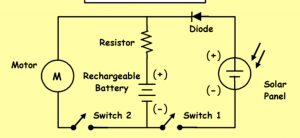Problem: Driving in remote and pristine regions


Some explorers, or nature lover, such as tourists, enjoy visiting and adventuring in wild and remote places because of its beautiful landscape, and driving in these regions with attractive natural panoramas around them. Although these driving tours are always exciting, there are always some who’s car would run out of fuel or electricity (Tesla), due to the great distances that the tourists need to travel in one trip, and gas stations and Tesla chargers that supply energies required for the vehicle are unavailable in pristine regions around the world. To avoid these obstacles, tourists must drive a type of car that relies on renewable and natural energy in such pristine regions. The two most common types of energy that comes from our mother nature, solar and wind energy, are probably the most useful energy that we could use for our cars during a trip in remote regions. However, it would be more reasonable to use solar energy in such regions because it is always accessible as long as light is available in the region, which is particularly useful during the day. Winds is indeed a good source of energy. However, it is unlikely to work for cars since winds are not always available in any places around the world. Despite the fact that the climate could suddenly alter in mountainous regions, and the valleys between the hills are rich in wind energy, the type of wind are also wind gusts. Concurrently, the higher elevation or altitude in mountainous regions provide more sunlight with the thinning of the atmosphere, making the sunlight more powerful, and intense simultaneously. As a result, solar energy became the energy that I will be using, and it would provide energy for a transportation tool that could make the car drivers through.
Precedents
Solar Car

Link: https://www.cartrade.com/blog/2015/greens/solar-cars-pros-and-cons-1181.html
Since our sun is an immutable source of energy, it is always the most sustainable energy for producing electricity to run the car engines. Comparing to cars that rely on electricity and fossil fuel, and running out of battery or fuels easily during a long distance trip passing through pristine regions with rare or no metropolitan areas, solar vehicles are less likely to run out of batteries since remote regions are always open spaced, where sunlight are always available during days, in which the cars could be easily charged and acquire adequate solar energy for charging. Concurrently, the solar cars have a faster speed comparing to gasoline and diesel cars due to its aluminum and lightweight components that made up the entire vehicle. Apart from travelling benefits, solar vehicle is also known as a type of green transportation, which would have multiple positive impacts and advantages. To begin with, solar vehicle is eco-friendly, which benefits the environment by not polluting (greenhouse gas emission) the environment. According to recent researches, the emission level of solar-powered vehicles stayed at zero. The transportation utilizes renewable energy, and the electric motors would not generate electricity emitting contaminants that are hazardous to our nature. Moreover, the quietness of solar-powered car would not distract thee environment. The enormous thrust that diesel and gasoline vehicles’ engine exerted could make loud noises that could be distracting to the ecosystems in remote regions, and thus ravaging the life cycle of the biodiversity.
Solar Ship

Link:https://www.amlu.com/2018/04/14/tesla-of-the-sea-soelcat-12-is-a-solar-powered-electric-catamaran/
This is a picture of the Tesla of the Sea: SoelCat 12, a solar-powered ship produced by the Dutch company of Soel Yachts. It is not only a luxury watercraft, but a symbolization of future water transportation. This ship, in particular has a functional solar electric propulsion system, which has a maximized efficiency, ideal for 24-hour services, the 16-person craft has a range of 150nm. Since the ship is not a diesel engine transportation, SoelCat 12 is a noise-free vessel, thus tourists could only hear water when the ship’s “engines” are set, and thus avoiding the noise contamination of water. Also, this could eliminate the possibility of water pollution because the energy that the ship exerted would have 0 level greenhouse gas emissions. Apart from efficiently using renewable energy, this boat could also allow the tourists to have a safe and comfortable trip since it provides sofa, food, and other daily necessities. In the discussion of pristine and remote areas, this boat could probably fulfill the tourists’ requirements during a medium length trip. However, it would not support long trips across the sea because the distance, and the pressure in some oceanic regions are not suitable for this tiny solar-powered boat.
Brief Description of solar circuit

I found this circuit as my precedent circuit because it is indeed simple and would not take a lot of space for my product. This is a solar-motor circuit where a diode is located on the wire connected to the positive charge of the 6-volt solar panel to prevent the charge from the solar panel from returning to solar panel, and damaging the overall circuit. In between the motor and the solar panel, a battery pack is being placed to act as a storage battery, and a resistor must be added between the battery, and the solar panel because the charge from the battery would ravage the solar panel if its voltage surpass the solar panel’s voltage. 2 switches are added on each side of the circuit. 1 of them (left of the picture) is used for operating the motor, and the other (right of the picture) is used for charging the motor.
Leave a Reply